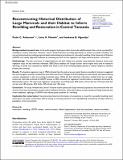| dc.description.abstract | Backgroundand research aim:In the anthropogenic landscapes where historically wildlife existed, there can be a potential for rewilding to reverse extinction. However, there is limited literature providing approaches to achieve successful rewilding. The current study aimed at providing empirical based methodological procedures for successful rewilding of the University of Dodoma (UDOM) and nearby degraded landscape by assessing past and current vegetation and large mammal species’ occurrence.
Methodology:The past occurrence of mega-herbivores and their habitat was assessed using systematic literature survey, past vegetation maps and key informant interviews. EBSCOhost database and Google Scholar search engine were used for literature searching. A survey was conducted at UDOM area which is one of the remaining habitat patches in central Tanzania to examine present plant diversity.
Results:The baseline vegetation map of 1960 indicated that the study area was mainly Savanna woodland. Literature suggested that anthropogenic activities resulted into Land-Use Land-Cover Changes (LULCC) leading into wild animals’ extirpation leaving remnant populations in the surrounding protected areas. While the key informant interviews verified local loss of mega-herbivores, field data collected at UDOM campus in 2022 indicated the vegetation transformation to bushland dominated by Dichrostachys cinerea. The area’s past vegetation composition was 33% grasses, 29% herbs, 21% shrubs and 17% trees while the current was 18% grasses, 42% herbs, 30% shrubs and 10% trees.
Conclusion:The study revealed that central Tanzania hosted spectacular large mammal populations that interacted with the savanna which has recently been transformed to bushland. However, observed evidence on past existence of large mammals and recent elephants’ sightings at UDOM area indicate great potential for rewilding.
Implication for conservation:Reconstructing historical information of ecosystems is crucial for successful rewilding. Such information can guide conservation efforts aiming at reversing extinction and reestablishing connectivity of large herbivore population across ecosystems. | en_US |

